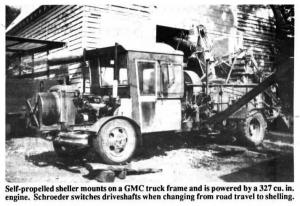Home-Built Corn Sheller Shells 250,000 BU/Year
 ✖  |
Alfred Schroeder has been custom shelling corn for 27 years, always using equipment he built himself. His latest self-propelled machine is such an eye-catching collection of miscellaneous parts he can stop traffic on just about any highway he drives down.
He takes the rig all over Carroll County, Iowa, traveling at speeds up to 45 mph. Depending on how much help is available, he can shell 600 to 1,200 bu. per hour. "We shell 200,000 to 250,000 bu. of corn each year," he told FARM SHOW.
To build the machine, Schroeder started with the chassis from a 2-ton 1954 GMC truck. A Chevy 327 motor with a 4-speed transmission provides the power. Both road drive and shelling are belt-driven. It's set up so that when changing from road travel to stationary shelling, he simply switches drive-shafts. The motor runs at 2,100 rpm's when shelling, burning 21/2 to 3 gal. of gas per hour.
The cab was built out of two junked tractor cabs. The sheller is an antique "pre 1942" Minneapolis Moline B2 separating unit. A husk blower, mounted just behind the cab, was taken from a MM 1210 sheller as was the ear corn hopper. A self-cleaning screen from a Gleaner combine mounts ahead of the radiator.
There are two hydraulic pumps. One powers the steering and raises the hopper while the other powers the unloading auger and runs 4 to 5 sections of drag. He has also built 3 independently-powered drag augers that can be positioned around the machine. A big blower pipe blows husks into a high-sided 8 by 14-ft. husk wagon. Cobs unload out the side into a wagon and shelled corn is augered out the back. Both the cob elevator and the unloading auger swivel 180?.
The only change Schroeder says he'd make on the machine would be to make the wheelbase a bit longer since it carries a lot of weight on the rear end.
Contact: FARM SHOW Followup, Alfred Schroeder, Rt. 2, Box 189, Breda, Iowa 51436 (ph 712 673-2381).

Click here to download page story appeared in.
Click here to read entire issue
Home-Built Corn Sheller Shells 250,000 BU/Year COMBINES Conversions 15-1-26 Alfred Schroeder has been custom shelling corn for 27 years, always using equipment he built himself. His latest self-propelled machine is such an eye-catching collection of miscellaneous parts he can stop traffic on just about any highway he drives down.
He takes the rig all over Carroll County, Iowa, traveling at speeds up to 45 mph. Depending on how much help is available, he can shell 600 to 1,200 bu. per hour. "We shell 200,000 to 250,000 bu. of corn each year," he told FARM SHOW.
To build the machine, Schroeder started with the chassis from a 2-ton 1954 GMC truck. A Chevy 327 motor with a 4-speed transmission provides the power. Both road drive and shelling are belt-driven. It's set up so that when changing from road travel to stationary shelling, he simply switches drive-shafts. The motor runs at 2,100 rpm's when shelling, burning 21/2 to 3 gal. of gas per hour.
The cab was built out of two junked tractor cabs. The sheller is an antique "pre 1942" Minneapolis Moline B2 separating unit. A husk blower, mounted just behind the cab, was taken from a MM 1210 sheller as was the ear corn hopper. A self-cleaning screen from a Gleaner combine mounts ahead of the radiator.
There are two hydraulic pumps. One powers the steering and raises the hopper while the other powers the unloading auger and runs 4 to 5 sections of drag. He has also built 3 independently-powered drag augers that can be positioned around the machine. A big blower pipe blows husks into a high-sided 8 by 14-ft. husk wagon. Cobs unload out the side into a wagon and shelled corn is augered out the back. Both the cob elevator and the unloading auger swivel 180?.
The only change Schroeder says he'd make on the machine would be to make the wheelbase a bit longer since it carries a lot of weight on the rear end.
Contact: FARM SHOW Followup, Alfred Schroeder, Rt. 2, Box 189, Breda, Iowa 51436 (ph 712 673-2381).
To read the rest of this story, download this issue below or click
here to register with your account number.







